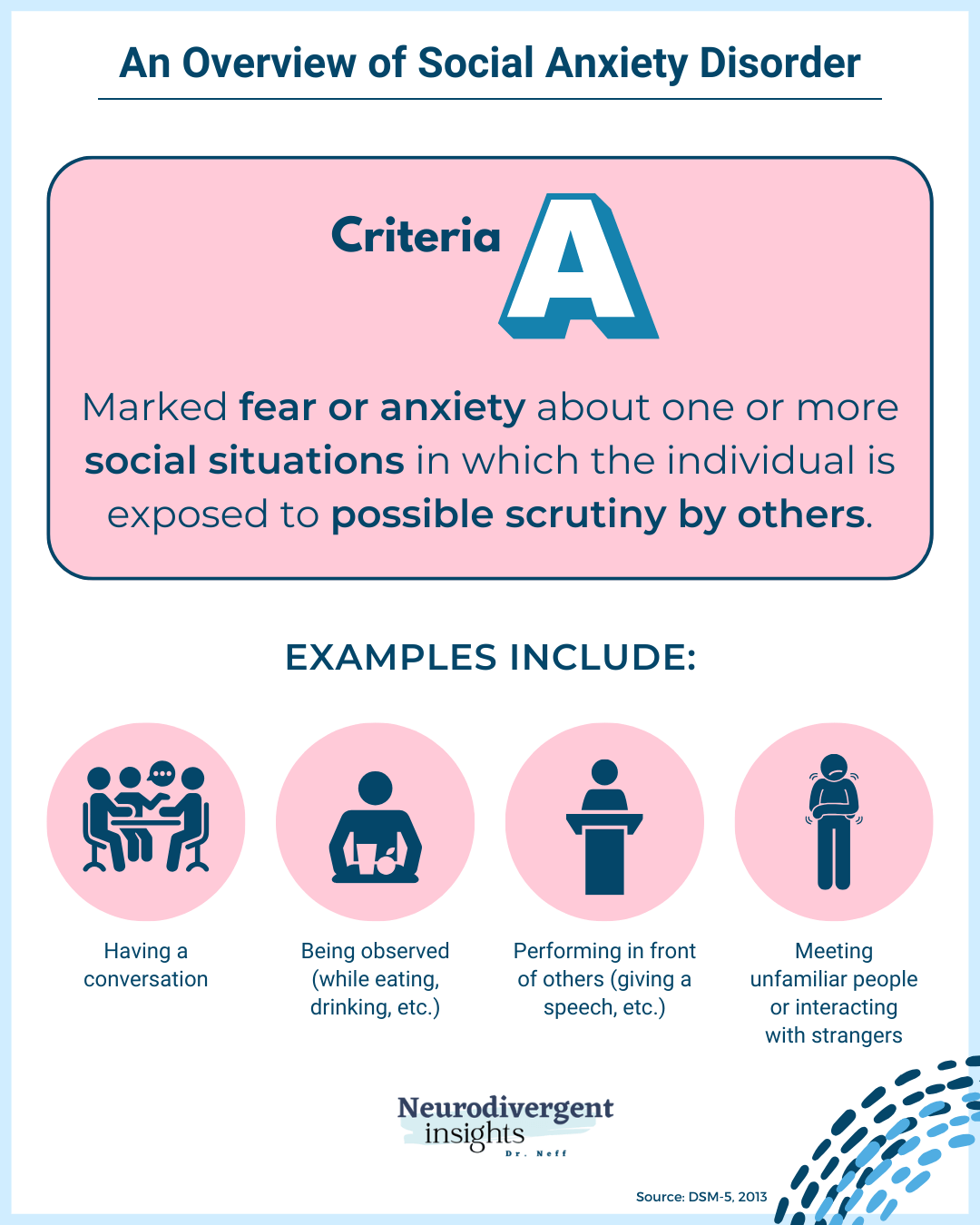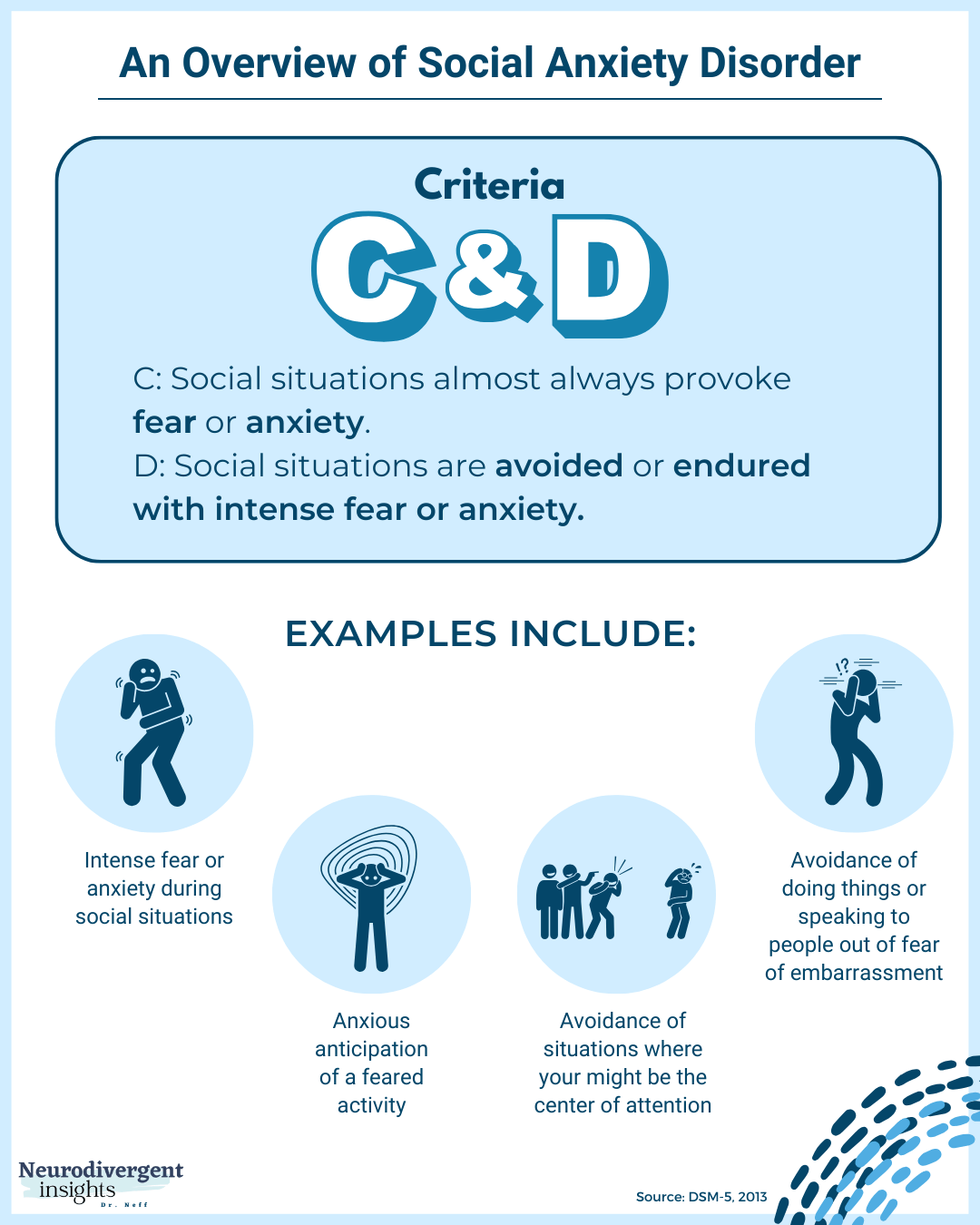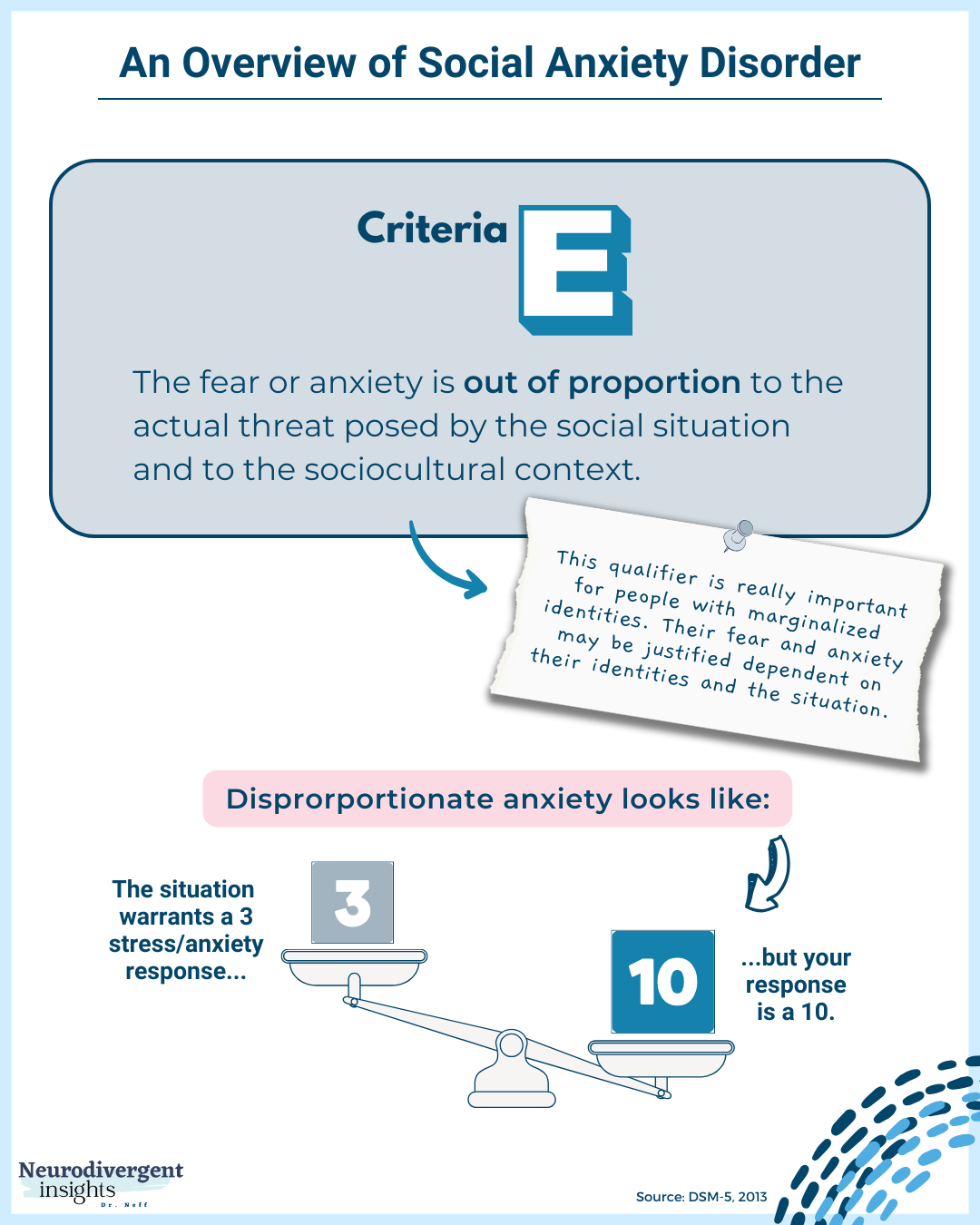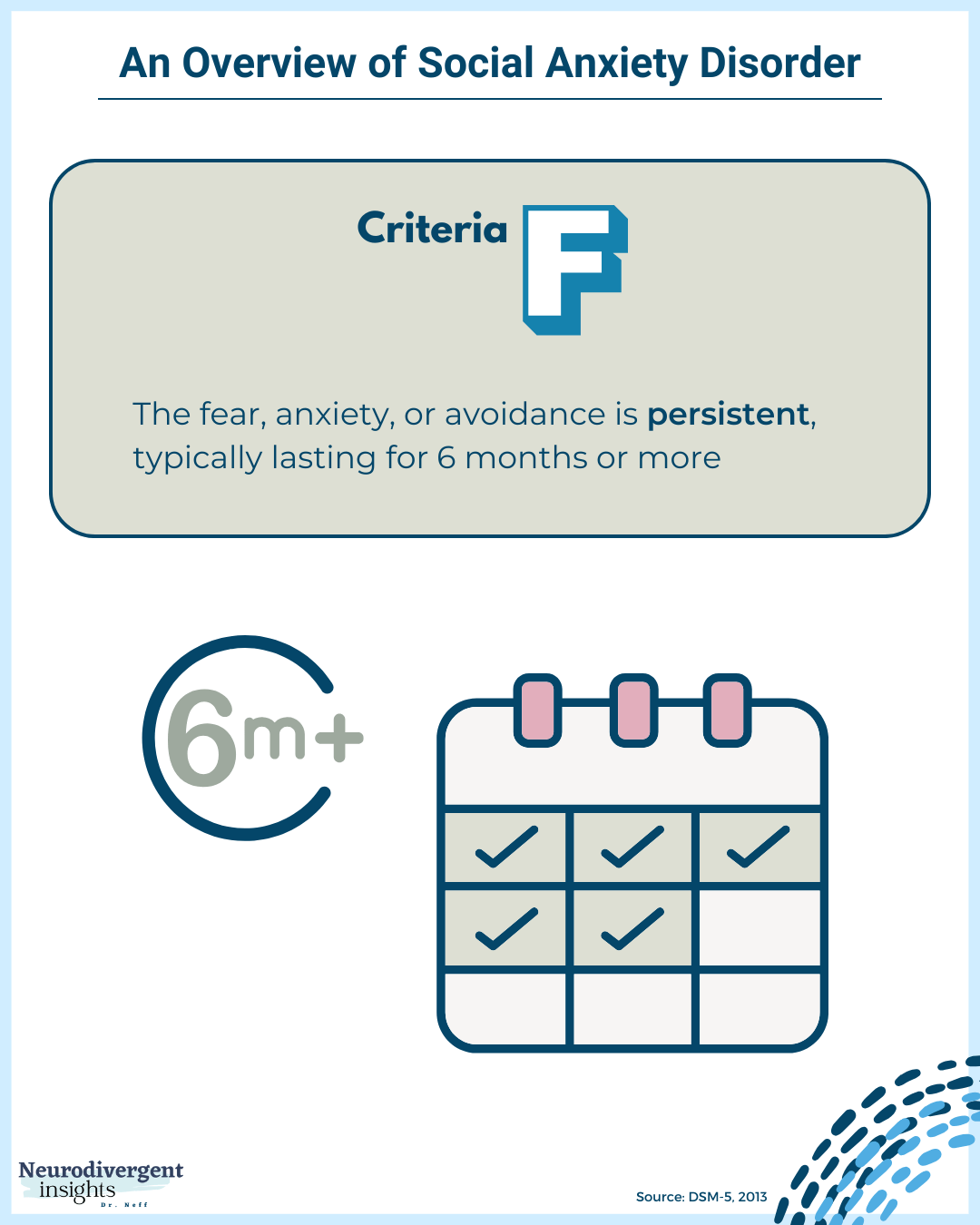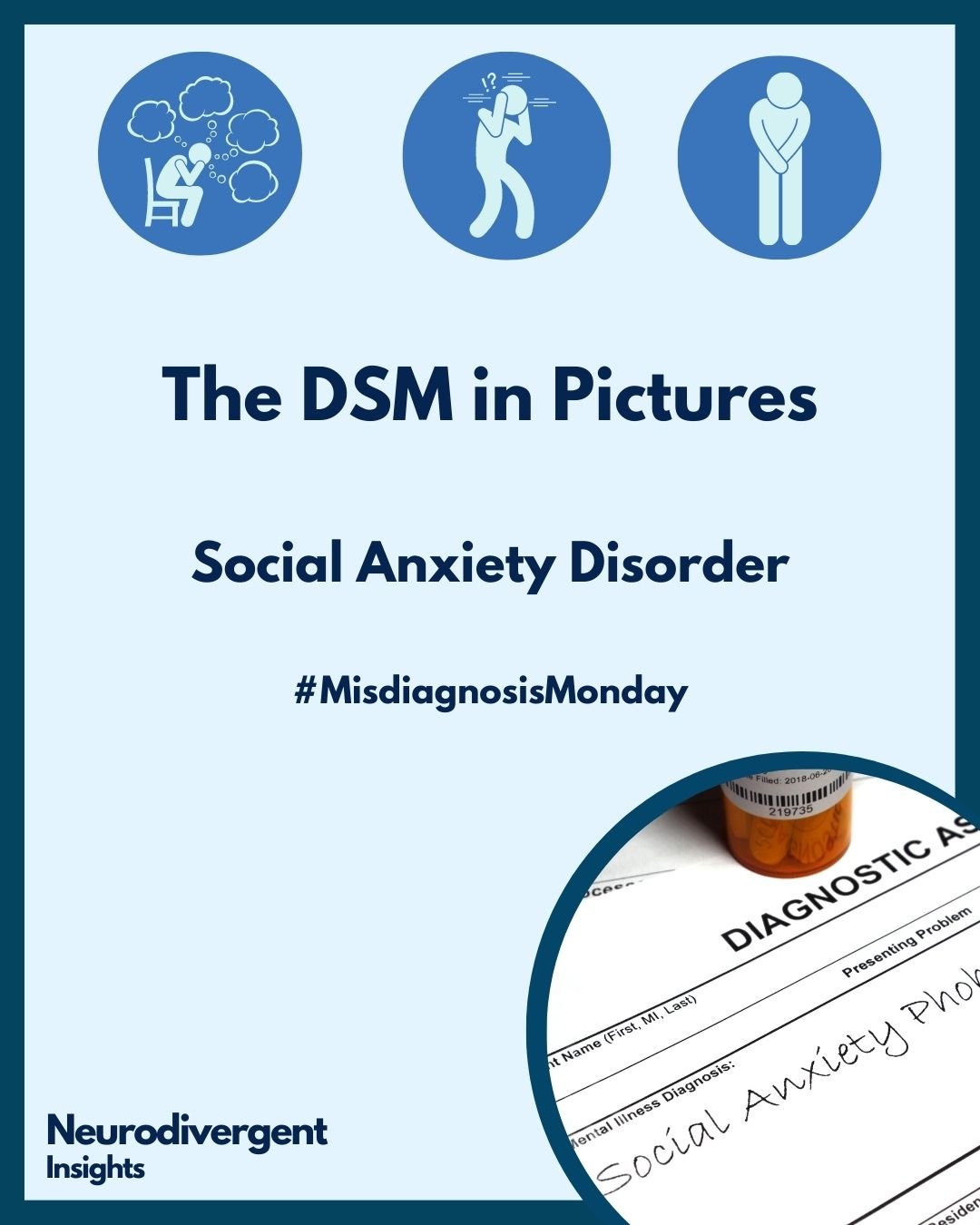Social Anxiety Explained (in picture form)
Introduction to DSM-5 Picture Series
I am creating a new series over on Instagram and here on my website. I will be taking commonly diagnosed conditions and reviewing the DSM-5 criteria in picture form. You can also download a high-quality PDF of these images over in my shop. Before diving into the DSM-5 criteria for social anxiety disorder, let’s first go over some basic information and disclaimers.
Disclaimers, FAQs, and Basic Information on the DSM-5
Why am I creating this Series: Glad you asked; here is why:
1). Like many Neurodivergent people, I can't understand a thing unless it's visual. I want to help break down the complexity of diagnosis codes through images.
2). The mental health world can be overly mysterious and opaque. As someone who regularly assesses and diagnoses people, I want to increase the transparency of what goes into diagnoses and assessments. Reducing uncertainty is helpful for all people but particularly important for Autistic people.
What this is: Educational.
What this isn't: A substitute for medical advice, a diagnostic tool.
A word on language: I use the language of the DSM for educational purposes; much of this is pathological by nature. It doesn't mean I agree with all the wording (in fact, I do not!).
What do A, B, and C mean? The DSM is broken into different criteria buckets. While a person doesn't need to have all symptoms of each criterion, they typically need to have all criteria met (A, B, C, etc..) to be diagnosed.
What about international people? The DSM-5 is based in the United States (the Psychological Association of America puts it out). However, the criteria are very similar to the ICD, which is used globally and broadly in medical settings.
Social Anxiety Disorder (Social Phobia) DSM-5 Criteria
There are 10 different buckets of criteria that need to be met for a person to be diagnosed with social anxiety. In the DSM-5 these are categorized from A-J.
Criteria A for Social Anxiety Disorder
Criteria A for Social Anxiety Disorder
Criteria A for social anxiety includes: "Marked fear or anxiety about one or more social situations in which the individual is exposed to possible scrutiny by others" (The DSM, 2013).
This is an important part of social anxiety to understand. Social anxiety is not the same as simply being anxious around others or feeling sensory overloaded. Rather the intense fear of being ridiculed, scrutinized, and embarrassed drives much of the anxiety.
Common experiences that can cause anxiety include situations where the person will be in the spotlight (such as giving a presentation or speech), having a conversation with someone (particularly someone new or unknown), and situations where they are observed by others (such as eating or drinking in public spaces).
***One specifier for social anxiety is if it is only present when performing or speaking in public. This can still be diagnosed as social anxiety with the specifier of performing only. This form of social anxiety is typically mostly causing impairment in a person’s professional life (for example, performers, musicians, athletes, etc.).
Criteria B for Social Anxiety Disorder
Criteria B for Social Anxiety Disorder
Criteria B for social anxiety includes: "The individual fears that he or she will act in a way or show anxiety symptoms that will be negatively evaluated." Examples include things such as:
1) Fear of being humiliated or embarrassed
2) Fear of situations where one may be judged negatively
3) Fear of physical manifestations of anxiety (blushing, sweating, trembling, or a shaky voice)
4) Fear of offending others
5) Fear of being rejected
Here the person is highly anxious that others will perceive them as "anxious, weak, crazy, stupid, boring, intimidating, dirty, or unlikable" (DSM-5, 2013). The person is often particularly nervous about showing their anxiety symptoms through blushing, trembling, sweating, stumbling over words, or staring, which will lead to being rejected or negatively evaluated.
Those from more collectivistic cultures are more prone to worry that they will accidentally offend others (through a gaze or by their outward signs of anxiety).
Criteria C and D for Social Anxiety Disorder
Criteria C and D for Social Anxiety Disorder
C. Social situations almost always provoke fear or anxiety.
Criteria C captures the pervasiveness of the experience. We aren’t talking about situational anxiety that comes and goes; we’re talking about anxiety that is persistent and present in many contexts.
D. The social situations are avoided or endured with intense fear or anxiety.
Avoidance and anxiety go hand and hand. When we experience anxiety, we often avoid the thing that triggers the anxiety (which then makes the anxiety worse, often referred to as the anxiety-avoidant loop). Criteria C and D capture this element of social anxiety. The person nearly always pushes through the avoidance but experiences intense fear and anxiety (criteria c), or they avoid these situations whenever possible (avoidance).
Criteria E for Social Anxiety Disorder
Criteria E for Social Anxiety Disorder
Criteria E is important for distinguishing situational or context-dependent anxiety that is justified based on risk or sociocultural factors from anxiety that is excessive in nature. For a person to be diagnosed with social anxiety disorder, the anxiety needs to be excessive and persistent.
One of the ways to discern if the anxiety is excessive is to look at whether or not it is proportional to the situation. This is a critical consideration, particularly when working with people with marginalized identities.
This is an area where BIPOC, Trans, and Neurodivergent people are often misunderstood. When your skin color or gender can be a source of danger and harm, the anxiety associated with many social situations is proportional to the risk. Or when you've spent a lifetime of not fitting in and not understanding why (re autism), the anxiety may be proportional to the context and past experiences.
Personally, in these situations, I prefer to frame the symptoms in the context of society vs. locating the disorder within the person. The person doesn't have a social anxiety disorder, rather, the sickness is in the society, and they are having an appropriate response to navigating a racist, transphobic, homophobic or ableist world.
Criteria F for Social Anxiety Disorder
Criteria F for Social Anxiety Disorder
For the majority of DSM-5 diagnoses, a specific amount of time needs to have passed before a person reaches the threshold of diagnosis.
For example, a person must experience two weeks of depressive symptoms before a diagnosis of major depression is given, 30 days of acute stress symptoms before a diagnosis of PTSD, and so on).
For social anxiety disorder, there needs to be a pattern of anxiety observed over the last six months.
This may seem arbitrary, however, having time requirements is generally helpful as it helps to tease out the difference between a major anxiety or depressive disorder and situational anxiety or situational mood symptoms (these situations often fall into the category of adjustment disorders).
Criteria G Social Anxiety Disorder
Criteria G for Social Anxiety Disorder
While I am a huge fan of the rise of mental health awareness and education happening in places like TikTok and Instagram, there are also some drawbacks. When a checklist of symptoms is put out, or someone shares a 60-second clip of their experience, it can be easy to relate to these experiences and start identifying with many of these conditions.
In some cases, this is accurate, and the person is finally finding language to understand their experience! However, at other times, a person may over-identify with these simplified checklists.
For example, most people likely experience occasional social anxiety. However, for a diagnosis, the symptoms need to cause either A) significant suffering or B) impairment in school, work, relationships, or another area of a person's life. The difference between fleeting social anxiety and social anxiety disorder largely comes down to this element—how much is it impacting the person's life?
I appreciate the DSM says "clinically significant distress" or “impairment.” This takes into account people with high-functioning anxiety who may not be experiencing significant work or school struggles but whose mental and emotional health is struggling due to the intensity of their symptoms.
Criteria H, I, J for Social Anxiety Disorder
Criteria H, I, J for Social Anxiety Disorder
When we get to the last few criteria (for almost all DSM-5 diagnoses), we start talking about disqualifiers. By disqualifiers and rule-outs, I mean we are looking to ensure that the symptoms and experiences aren't better explained by another condition (another medical condition, mental health condition, substances, etc.). In general, you want to diagnose less and better. By this, I mean if you can explain the person's symptoms in one diagnosis, that is preferred over providing 2 or 3 diagnoses.
Let me give an example. In the case of PTSD, the person would likely meet the criteria for generalized anxiety disorder and major depressive disorder (based on symptoms). However, these symptoms are best explained by PTSD, and it requires fewer diagnoses. So the person would be diagnosed with PTSD (not all three).
This is important as it helps guide the treatment. In the above example, it is assumed that as PTSD is treated, depressive symptoms and anxiety symptoms would also improve. If they don't, it may be time to revisit and consider adding a depression diagnosis if it is lingering beyond the PTSD symptoms and treatment.
Many undiagnosed Autistic and ADHD people are diagnosed with social anxiety. If you like to learn more about the similarities and differences between social anxiety and autism, you can check out my brief e-book on it.
Further Resources
Social anxiety can be tricky to spot, especially among neurodivergent people, many of who experience understandable anxiety as they navigate a world not designed for them. For more resources on social anxiety and Autistic anxiety here are a few further resources:
1) Social Anxiety vs. Autism E-book: In this e-book I walk through the criteria for both and tease out the differences.
2) A Strength-Based Perspective of Anxiety: In this masterclass with Dr. Dalton he provides an overview of anxiety, reviewed the differences between adaptive anxiety and disordered anxiety and discusses atypical anxiety as often seen among Autistic youth and young adults.
3) You may also find these other free articles of interest:
Older Graphics




